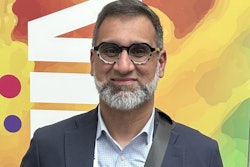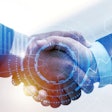In 1989, the Society for Computer Application in Radiology (SCAR) was formed by a small group of pioneers who could see that medical imaging was on the verge of undergoing a revolutionary change. In 1996, the Radiology Information System Consortium (RISC) and SCAR merged under the SCAR name to include individual, corporate, and institutional members.
 Michael J. Cannavo.
Michael J. Cannavo.
Fast forward to 2006 and SCAR became the Society of Imaging Informatics in Medicine (SIIM) to “better reflect the broadening role of imaging across the medical enterprise.” Same group, same basic purpose, only larger. It has continued to grow over the years and has done an outstanding job in keeping technological advances like PACS and AI at the forefront. My mentor, Dr. Samuel J. Dwyer III, was an integral part of the SIIM back in the early days of SCAR when people didn’t even know what PACS was, and he got me involved in it way back then.
While the SIIM has evolved to focus on career training like the Certified Imaging Informatics Professional (CIIP) certification, PACS systems analysts, standards development, and other areas, its annual conference is more of a networking show. The SIIM deals with evolving technologies, not more mature or even developing technologies like those shown at the annual RSNA meeting in Chicago each year. Even though PACS has been around almost 40 years and is considered pretty mature, by most, it too is evolving, moving away from on-premise offerings to Cloud-based implementations.
What’s real
What’s real and not from an AI technological perspective still remains to be seen. More than half of the panel discussions featured academic facilities talking about how they were using AI technology, yet it was evident that many were learning about the technology in real-time. It was excellent to hear their perspectives and input, but glaringly apparent that we weren’t talking about a mature technology by any means. Several vendors on the panels did an admirable job of maintaining vendor neutrality while referencing how they do things, but, as expected, they seemed somewhat limited in their ability to look at things from a more global perspective.
I also managed to sit in on nearly a dozen educational sessions. The SIIM did an excellent job from a technical standpoint with crisp video and clear audio. The panels were an interesting mix of individuals, although many were from the academic world, whose requirements for using new technology significantly differ from those in the community or even the integrated delivery network (IDN) sector. The focus was almost exclusively on patient care.
While this is indeed critical, it alone will not get the technology used clinically except in an academic setting. That said, it was good to hear some real-world applications of AI, such as having AI initially evaluate unread chest x-rays and prioritizing them so that any study with a negative finding was put to the top of the stack for review and possible action, significantly expediting report turnaround time.
Cost justification
The missing elephant in the room seemed to be how to justify AI, at least until the U.S. Centers for Medicare and Medicaid Services (CMS) includes all versions of AI in various reimbursement settings. This excludes the New Technology Add-on Payment (NTAP) program that impacts only a handful of companies currently. There is a bill to amend title XVIII of the Social Security Act to ensure appropriate payment of certain algorithm-based healthcare services (S.1399 or the Health Tech Investment Act) for AI-enabled medical devices approved by the FDA. Unfortunately, no mention was made of this in the sessions I attended.
Given the numerous governmental cuts being made, this bill may not make it through the Senate. It’s still worth mentioning, however. Several vendors have also had success with private payers paying for the use of AI technology, but the rate structure they are being reimbursed at most likely won’t make it on a widespread basis. One study showed 11 billion claims analyzed from January 2018 through June 2023. Just 16 procedures were billable under Current Procedural Terminology (CPT) codes, with only four of the 16 having over 1,000 claims submitted.
This data was current through mid-2023, and while it has increased since then, it has not increased significantly. Again, in an academic or university setting, reimbursement isn’t a primary focus, although it certainly is for the 70% of hospitals and imaging centers that make up global healthcare in the U.S.
It seemed like most of the presentations (and associated questions) were directed at those who already used technology like AI, specifically academic facilities. This makes sense when 36% of SIIM attendees are universities (43% if you count those with a nonhospital university presence). From an AI standpoint, this is great as these sites often have the financial and internal resources to implement AI and can both build off others’ experiences and share their own.
Sadly, less than 10% of SIIM attendees are from community hospitals and IDNs, and just 5% of the attendees are from imaging centers and private practices. These are the target markets for smaller PACS providers and even entry-level AI companies that don’t have millions in revenue to fund them. Realistically, there are also at best a handful of vendors who can provide PACS to the mega-institutions, so a lot of the smaller vendors got shut out of the game, even though on occasion, I have seen a David and Goliath win.
Entry-level sessions
Respectfully, what the SIIM needs in addition to the geek sessions and presentations is entry-level presentations where you don’t need a handbook of abbreviations to help understand what people are talking about and speakers who put things in a real-world setting.
I was very glad to see cybersecurity touched on, as this is beyond crucial in today’s world. Workflow was the buzzword used almost everywhere, with everyone defining it slightly differently. It was great, too, to see that the reality of a cloud-based PACS as more than just plug and play with the three major cloud providers (Amazon, Microsoft, and Google) presenting their products and services in the vendor exhibition area.
So would I go to the SIIM in person next year? Maybe. Portland, OR, was just too far and costly for me and many others to go to. And while I missed out on the onsite, one-on-one interaction with vendors, I got what I needed from the sessions as well as from several I know who attended the show. If history repeats itself, the SIIM will go from Portland to Pittsburgh in 2026 (already announced) and then to Maryland in 2027.
Orlando was way back in 2012 (excluding a few Healthcare Information and Management Systems Society (HIMSS) meetings in 2017, 2019, and 2022), so I think we are well overdue. Besides, not only do Disney and Universal have all sorts of new stuff to see and do (not to mention our top-notch golf courses) but by the time our number comes up, AI will also be a lot more real. The venue will also allow me to do the show from start to finish and still sleep in my own bed at night, which, as many will tell you, is absolutely worth its weight in gold.
Michael J. Cannavo is known industry-wide as the PACSman. After several decades as an independent PACS consultant, he worked as both a strategic accounts manager and solutions architect with two major PACS vendors. He has now made it back safely from the dark side and is sharing his observations.
His healthcare consulting services for end users include PACS optimization services, system upgrade and proposal reviews, contract reviews, and other areas. The PACSman is also working with imaging and IT vendors developing market-focused messaging as well as sales training programs. He can be reached at [email protected] or by phone at 407-359-0191.
The comments and observations expressed are those of the author and do not necessarily reflect the opinions of AuntMinnie.com.



















